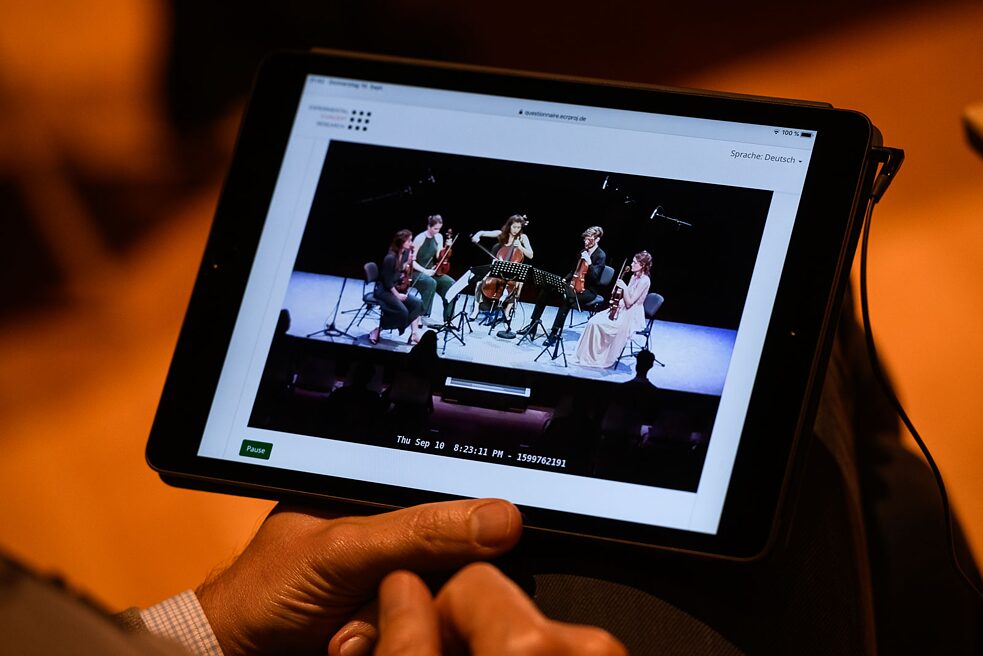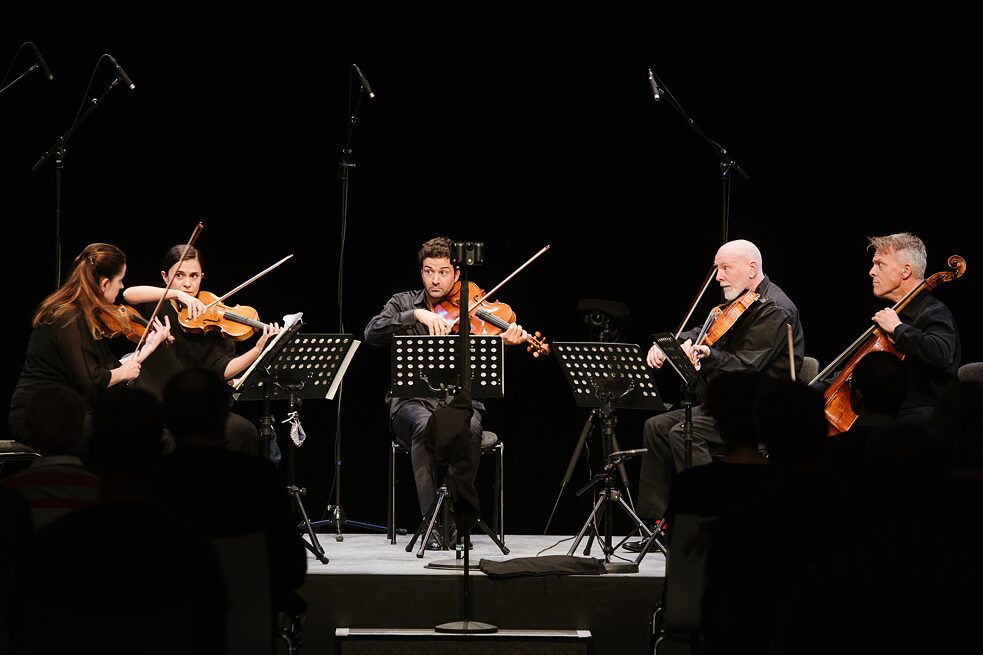Experiencing Concerts at a Distance
Digital Music Spaces

The event industry, and especially live music events, was one of the first sectors of the economy to be shut down in Germany when the coronavirus pandemic began in March 2020. Musicians and fans did not let this stop them enjoying shared musical experiences, however. Digital spaces offered refuge during a time of contact restrictions. Which future prospects do they offer?
By Thomas Winkler
Who knows, if it weren’t for the pandemic the world might never have discovered that popstars are just as reliant on vacuum cleaners as ordinary mortals are. Or at least Mine is, as we found out when the Berlin-based musician gathered together the “Quarantöne All Stars”. Together with four fellow musicians, she can be seen on Youtube reinterpreting her song Hinterher. What makes the recording special is that all of them are singing and playing their instruments on their own at home, with technology then being used to combine the sounds as if they were performing normally as a group – and in Mine’s living room a completely bog-standard and very unglamorous household appliance can be spotted in the background. “Hey Mine, we’ve got the same Hoover!”, a certain “storlach” declares delightedly in the comments. “So I’ll soon be able to sing just like you!“
“10 months later, just as up-to-date, just as beautiful, just as inspiring. Balm for the battered souls. Thank you, thank you, thank you for that!”
commented a Youtube viewer in 2021 on the new interpretation of Mines song Hinterher.
“It brings tears to my eyes … apart from the goosebumps,”
says another viewer on Youtube.
Atmosphere created by digital avatars
Although the “Quarantöne All Stars” were a success, their music manager Habels Agentur – which played a key role in their organisation – does not believe that such complicated formats will survive once the pandemic comes to an end. Concerts will continue to be streamed, just as they were before the coronavirus, “as this is the modern-day equivalent of the live DVD for those established artists who no longer wish to perform in every small town. However, everyone will be happy to return to the normal rhythm as quickly as possible. After all, the atmosphere that a live gig offers cannot be reproduced – neither for the artist nor for the fan.”This is a view that is shared by Christian Weining. Nonetheless, the cultural studies expert from Zeppelin University in Friedrichshafen is working on a model project that is attempting to create a digital concert experience that is as close as possible to real life. Weining is coordinating the “Experimental Concert Research” project in which scientists from universities in New York, Bern, Klagenfurt and Karlsruhe are trying to identify what exactly defines a concert experience. The key question that this music and cultural science project wishes to address is: “What distinguishes a concert from other ways of listening to music?”
 Sneak Peak Yubal Ensemble | Photo (detail): © Phil Dera
Sneak Peak Yubal Ensemble | Photo (detail): © Phil Dera
Since the study's findings were published at the end of 2021, Weining can reveal “that such formats are of interest first and foremost to people who are very interested in music in any case and are given the feeling that they are attending an exclusive event”. When asked to draw some sort of conclusion, the scientist sums up as follows: “It is an alternative but could never be a substitute.”
 Sneak Preview Alban Gerhardt and Friends | Photo (detail): © Phil Dera
Sneak Preview Alban Gerhardt and Friends | Photo (detail): © Phil Dera
“We are still here!”
This is also what the organisers of United We Stream experienced. A digital platform that was established by the Berlin Club Commission right at the start of the first lockdown in March 2020, it features live streams of DJs performing to empty dancefloors at the city’s world-famous but abandoned clubs. Its primary objective was to maintain contact with club-goers and convey a message to the wider public, namely: We are still here!This proved so successful that clubs from other cities across the world quickly joined in. These days the initiative is far more than just a streaming website, says Anna Harnes: she describes it as “a decentralised network, a movement, an open source platform” that links over 500 event venues in more than 120 cities in Europe, Asia, Australia, North and South America and has meanwhile managed to drum up more than 1.5 million euros in donations for clubs, artists and the sea emergency rescue organisation Sea-Watch: “The response has been so overwhelming that we are still hardly able to set up the necessary structures quickly enough.”
As Harnes, who is the organisation's chairperson, also points out however: “There is no substitute for human interactions in these clubs, as they also provide a safe haven for women, queers and other minorities.” This is also the reason why virtually no other sector has been as badly affected by the pandemic as the club scene. A party culture that is attractive not least for its excesses, self-staging, licentiousness and the anonymity of the night is hardly compatible with social distancing rules, compulsory facemasks or contact tracing. Reproducing such experiences online remains but a pipe dream.
Thanks to initiatives like United We Stream and the fact that DJs were able to keep in contact with their fans online rather than jetting round the world, “a closer bond has been created plus a greater awareness of what club culture means – and how important it is.“
“Please never end!”
comments “C-Real“ under the live stream from the club Ritter Butzke in Berlin on 27 March 2020.
United We Stream, on the other hand, will be changing its orientation in March 2022 to mark the platform’s second anniversary. Rather than simply streaming events, it will focus above all on continuing to interlink clubs around the world and promoting exchange within the scene. “We will move away from fundraising and towards a communication and cultural platform that provides space for debating typical club-related issues such as diversity, but also problems in the scene such as precarious employment conditions”, says Harnes. “It was never our goal to replace the live experience, but rather to create something additional. Dancing the night away in a club is simply unique.”